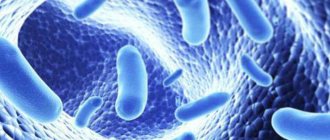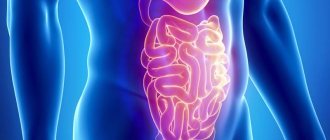Author of the article: Tironova Inna Igorevna
Gastroenterologist, therapist
15 years of experience
Professional skills: Colon hydrotherapy, treatment of gastrointestinal diseases
The color of stool is affected by both medications and food. Changes in stool consistency are possible due to the nature of the food you eat. As a rule, green diarrhea is a symptom of a disease unless it is caused by natural causes. If the color of stool changes, it is necessary to determine what caused the malaise and not delay treatment for a long time.
Causes of green diarrhea
The color of each person’s stool directly depends on what he ate the day before, but it can also change if pathologies of the gastrointestinal tract occur or with the development of other diseases.
Food
One of the reasons for the development of green diarrhea in an adult is food. There are many foods that turn stool green. Among the products that affect the color of feces are:
- Raw vegetables rich in fiber and natural iron: spinach, broccoli, lettuce.
- Seafood: tuna, seaweed, shellfish.
- Foods high in iron: beef liver, lentils, dark chocolate, cashews.
- A very common cause of stained stool is eating food rich in dyes (especially artificial ones).
Typically, these products affect the color of stool if they were eaten in large quantities. If you consume them insignificantly, most likely, the feces will not be colored.
Another safe factor that provokes a change in stool color is the consumption of foods that affect liver function. If you don’t understand why green diarrhea appears, remember if you ate sprouted rye. In large quantities, the product causes stool liquefaction and a change in the color of feces, as it is not completely digested.
Diet
For a quick recovery, the patient must adhere to proper nutrition. Easily digestible dishes should be the basis of the patient’s menu. Food intake is carried out in small portions.
Foods that can cause fermentation in the intestines - fresh fruits and vegetables - are not recommended. Alcohol and carbonated water are contraindicated. You should not eat foods high in carbohydrates. Spicy dishes and foods with a lot of spices should be excluded.
- Rice and oatmeal porridge with water.
- Boiled lean fish, as well as chicken or turkey fillet.
- Boiled vegetables.
- Dryers, biscuits.
- Unsweetened compotes, clean water, teas.
You should drink more fluids than usual, as dehydration can be a complication of diarrhea.
- Whole milk and cream.
- Canned food, sausages.
- Sour apples, kiwi, citrus fruits.
- Pork, fried meat.
- Soups with fatty broth.
Nutrition for intestinal upset should be reasonable. On the first day, reduce the amount of food to a minimum or eliminate it altogether. Then you can gradually introduce permitted products. If intestinal disorders occur frequently, it is better to limit the consumption of certain foods constantly.
Taking medications
Green diarrhea in an adult may occur due to the use of certain medications. The following medications affect the color of stool:
- Iodine-containing drugs.
- Dextrose.
- Vitamin complexes.
Iron supplements in excessive quantities provoke greenish diarrhea. Even if this element is only part of the vitamin-mineral complex, with significant overdoses, changes in stool are possible.
Intestinal infections
One of the most common causes of stool discoloration is digestive disorders caused by bacterial or viral infections. The main symptom of the disease is liquid, watery green stool, often with foam, and a strong, unpleasant odor.
Additional signs of pathology:
- A large amount of mucus in the stool.
- Nausea, sometimes vomiting.
- Slight increase in body temperature.
- Lack of appetite.
- Feeling of dry mouth.
Viral infections can be acute, with high fever. Symptoms of acute intoxication due to bacterial infection are also possible.
Situations when there is cause for concern:
- Development of dysentery.
- Infection with salmonella septic form.
- Dehydration due to any type of diarrhea.
Mild and moderate dysentery is accompanied by an increase in temperature. With this disease, not only the color of the stool changes. Blood streaks and cloudy mucus may appear in the feces.
Diseases of the gastrointestinal tract
Pathologies of the gastrointestinal tract can provoke changes in the color of stool and its consistency. The most common problems with the stomach and intestines that cause green loose stools:
- Enteritis . An inflammatory process affecting the mucous membrane of the small intestine. With pathology, diarrhea with greens appears. Dark green stools are also common.
- Enterocolitis . Simultaneous inflammation of the large and small intestinal tract. A characteristic symptom is frequent yellow-green stools.
- Stomach ulcer . With this disease, a common cause of green diarrhea is bleeding in the stomach. Blood gives feces a greenish tint because it is not completely oxidized (another type of stool coloring is tar-black). If you have black-green diarrhea, you should seek medical help immediately. Internal bleeding can quickly lead to sepsis and death.
Important! If bright red blood appears from the anus, this is a sign of damage to the rectum. This condition also requires medical attention.
Intestinal dysbiosis
One of the signs of dysbiosis is green diarrhea. This disease can be caused by the following factors:
- Staphylococcal infection.
- Long-term use of antibacterial drugs.
- Constant consumption of certain foods (especially strict veganism).
- Prolonged fasting.
- Unbalanced diet.
The factors listed above influence the qualitative and quantitative composition of the intestinal microflora. As a lack of lactic acid bacteria develops, stool may gradually become thinner and acquire a slightly greenish tint.
Possible complication of dysbacteriosis: constipation, enteritis, enterocolitis.
Diseases of the pancreas and gallbladder
In a healthy person, bile is green. It retains the same shade when released from the gallbladder. Normally, after passing through the intestines, bile gradually takes on a brown color.
Diarrhea is often considered a sign of dysfunction of the pancreas and gallbladder.
Pathologies in which liquid diarrhea of gray-green, yellow-green color occurs:
- Pancreatic dysfunction . Acute pain in the left hypochondrium on the right, nausea and vomiting are additional symptoms of the disease
- Pancreatitis . With a strong inflammatory process in the pancreas, the patient experiences green stool, often with a liquid consistency. This is due to a lack of enzymes needed for normal absorption of food from the intestines and giving the stool its natural brown color.
- Gallbladder dysfunction . It is characterized by the passage of unchanged bile into the stool.
Intoxication
A change in the color of the stool and its consistency can be a sign of intoxication. Green diarrhea may appear due to poisoning or overeating.
In this case, patients experience the following symptoms:
- Frequent vomiting.
- Watery, repeated profuse diarrhea.
- Headache.
- Acute pain in the abdominal area.
Bilirubin does not have time to take on a brown tint, which leads to the appearance of a greenish tint to the stool. When overeating, the patient feels pain in the stomach, a feeling of bloating and flatulence.
If diarrhea is caused by overeating, relief occurs after the stomach and intestines are free of food. If there is no vomiting for a long time and the feeling of fullness in the stomach persists, the patient's condition may worsen. Therefore, in case of intoxication caused by overeating, it is recommended to do gastric lavage.
Diagnosis and treatment
In order to get rid of loose green stools, you must first get rid of the reasons for its appearance. Therefore, you should not self-medicate, as the reasons can be different, sometimes leading to serious consequences. For diagnosis, you need to consult a doctor, who, in turn, will prescribe a series of tests, such as coprogram, blood and urine tests, and ultrasound to examine the abdominal cavity.
Depending on the diagnosis, treatment may consist of the following procedures:
- Taking medications. For example, when an intestinal infection is detected, antimicrobial agents are prescribed. Treatment lasts at least one week. To remove toxins from the body, sorbents are prescribed that prevent gas formation and fermentation in the stomach - Smecta, Enterosgel;
- Restorative process of microflora balance in the intestines. In the presence of dysbacteriosis, the doctor prescribes drugs that contain lacto- and bifidobacteria, as well as non-pathogenic E. coli - Bifikol, Bifidumbacterin. The course of treatment lasts about a month. At the same time, it is important to include in the diet the consumption of fermented milk products (milk, kefir, natural yogurt without additives). If the body is severely dehydrated, intravenous drips cannot be avoided;
- Taking enzymes if the body cannot fully produce them on its own - Immodium, Linex, Mezim. The course of treatment can last several months;
- Surgical intervention, the need for which arises only in the presence of bleeding. Most often, the method of laparoscopy is used for this, since it is less painful and the recovery period is shorter.
Medications
Treatment of greenish diarrhea must be discussed with a gastroenterologist. The most common problem that a person can expect is dehydration. Especially if an adult has developed yellow-green diarrhea of infectious origin.
For diarrhea, you should take the following medications:
- Enterosorbents . Help relieve intoxication and eliminate symptoms of poisoning.
- Probiotics . Stabilizes intestinal function, improving the composition of saprophytic flora.
- Antimicrobial drugs. They must be taken if the patient develops diarrhea of infectious origin.
- Antibiotics . Prescribed for bacterial diarrhea and peptic ulcers. Take strictly after meals.
- Fixing drugs . They help reduce the motility of the intestinal wall and stop the movement of the food bolus through the gastrointestinal tract.
- Antispasmodics and analgesics . Necessary for gallbladder dysfunction, pain in the intestines caused by frequent urge to defecate.
- Enzyme agents . They are taken in cases where green diarrhea is caused by a violation of enzyme production.
- Histamine receptor blockers . Prescribed for stomach ulcers to reduce the production of hydrochloric acid.
Any medications are prescribed by a doctor. The choice of drugs depends on the type of disease and the characteristics of its course. The presence of chronic diseases and the patient’s age are also taken into account.
Symptoms of illness in adults
Diarrhea is a painful and uncomfortable condition characterized by the following symptoms:
- frequent bowel movements;
- loose stools;
- attacks of abdominal pain;
- flatulence, accumulation of gases in the intestines.
In addition, this condition may be accompanied by fever, as well as other symptoms, such as:
- fast fatiguability:
- general malaise, weakness;
- pale skin;
- nausea, vomiting.
With such manifestations of the disease, compliance with the rules of dietary nutrition and rest may not be enough to eliminate them. In such cases, it is recommended to consult a doctor to exclude the development of complications.
Nutritional Features
If green diarrhea in an adult is caused by eating certain foods, the person simply needs to change his daily menu to include enough meat and dairy products. If the cause of diarrhea is illness, the patient should adhere to a low-calorie diet.
Completely excluded from the diet:
- Marinades and pickles.
- Smoked meats.
- Sweets, cakes, fresh pastries.
- Whole milk, ice cream, full-fat sour cream.
- Raw fruits, vegetables.
- Mushrooms.
- Alcohol-containing drinks
- Sodas, lemonades, juices.
Spicy foods can also cause diarrhea, so spices and seasonings should not be used when preparing dishes for the patient. In order for green diarrhea with water in an adult to go away as quickly as possible, in the first days of illness you need to follow a suitable diet. On the 2-3rd day of illness, eat crackers and rice porridge. And drink a lot - throughout the entire treatment period.
Prevention of the disorder
It is possible to prevent diseases that cause intestinal upset in the form of green diarrhea by following basic rules:
- Use fresh products and carefully monitor the expiration date when purchasing.
- Store food in the refrigerator and do not consume it if the expiration date has passed.
- Wash dishes thoroughly using detergent. Rinse afterwards.
- Visit catering establishments less.
- Drink only clean water.
- Wash vegetables and fruits with a weak solution of vinegar or lemon.
Wash your hands frequently with soap. Especially before eating, after visiting the street, after using the toilet. During epidemics, it is better to avoid visiting places where there are large crowds of people - mass events.
Green liquid stool means that not everything is in order in the body. The best option would be to seek qualified help. The doctor will make a diagnosis and give recommendations, adherence to which will contribute to a quick recovery. Preventive measures will help avoid disease.
Green diarrhea in an adult is an alarming symptom that should not be ignored. It indicates a violation of the digestive processes. The green color of stool is due to increased production of bile or active fermentation in the intestines.
What can you do at home if you have green diarrhea?
If a person has greenish diarrhea, his condition can be alleviated at home, before visiting a doctor. At home, treatment for an adult can be supplemented with the following folk remedies:
- Oak bark decoction . Helps firm the stool and also helps relieve inflammation.
- Infusion of walnut partitions . It has antiseptic properties and helps well with dysbacteriosis and overeating.
- Chamomile tea . Has an anti-inflammatory, calming effect. Helps get rid of flatulence and abdominal pain.
- St. John's wort decoction . Promotes tissue regeneration, relieves inflammation, and improves immunity. Thanks to tannins, it stabilizes stool during diarrhea.
- Ivan tea decoction . It helps well if an adult has green diarrhea due to peptic ulcers or other inflammatory diseases of the gastrointestinal tract.
The main condition for using folk remedies for green liquid stool in an adult is that the main treatment is prescribed by a doctor. Traditional medicine recipes can only complement drug therapy. Do not put off visiting a gastroenterologist until later. If you have diarrhea or a strange color in your stool, seek medical help.
( 1 ratings, average: 5.00 out of 5)
Traditional methods
To treat any diarrhea, doctors recommend taking astringent herbal remedies. They eliminate mild physiological diarrhea and speed up treatment in severe cases. All folk remedies are drunk at intervals of 1–2 hours from meals, the average course of treatment is 10 days.
Oak bark
Raw materials (3 tablespoons) are poured with boiling water (200 ml) and kept in a water bath for 30 minutes. Strain while hot, squeeze out the bark, add water to 200 ml. Drink 50 ml 3-4 times a day.
Pomegranate peels
Chopped fresh (2 tbsp.) or dried (1 tbsp.) peel is poured with boiling water (200 ml). Bring to a boil and steam in a water bath for 15 minutes. The broth is filtered and the volume is added to 200 ml by adding boiled water. Use 1.5 -2 tbsp. l. 3-4 times a day.
Bird cherry
The crushed bark (1 tbsp) is poured with boiling water (200 ml) and kept in a water bath for 30 minutes. The broth is infused for 1 hour and filtered. Take 100 ml 3 times a day.
Alder cones
The dried raw materials (50 g) are poured with boiling water (1 l), kept on low heat for 20 minutes and infused for an hour. The strained broth is taken 1 tbsp. l. 4 times a day.
Preventive actions
To reduce the risk of developing intestinal disorders accompanied by loose green stools, you must follow simple rules:
- observe the rules of personal hygiene: wash your hands thoroughly after visiting public toilets, places with large crowds of people, or contact with animals;
- eat only fresh foods;
- comply with food storage conditions;
- do not use food products that have expired;
- monitor the cleanliness of the dishes in which food is prepared and eaten;
- reduce eating in public places;
- Pour boiling water over vegetables or fruits before eating;
- follow the rules of heat treatment of meat and fish products;
- drink purified water.
When visiting countries with climates and dietary habits that are unusual for the body, it is not recommended to eat exotic dishes, as this can cause acute gastric disorders with stool disorders.
In conclusion, it is worth noting that the appearance of green diarrhea in adults can be caused by various reasons. If this condition is accompanied by acute pain, vomiting, nausea and fever, you must immediately consult a doctor for examination and treatment.
We recommend: Why does diarrhea occur after eating fatty foods?











